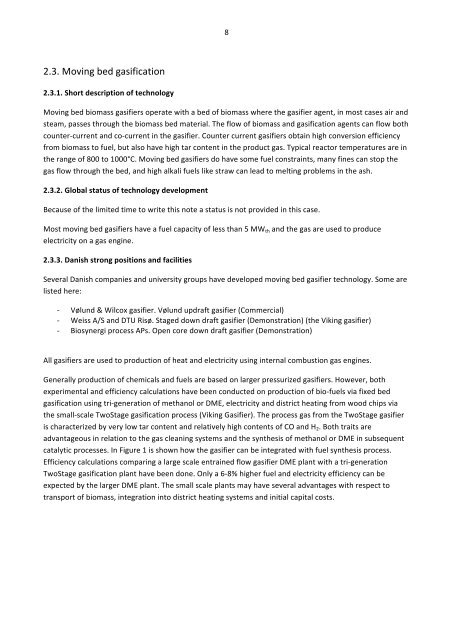Preliminary status note: Thermal biomass conversion technologies ...
Preliminary status note: Thermal biomass conversion technologies ...
Preliminary status note: Thermal biomass conversion technologies ...
You also want an ePaper? Increase the reach of your titles
YUMPU automatically turns print PDFs into web optimized ePapers that Google loves.
2.3. Moving bed gasification<br />
2.3.1. Short description of technology<br />
8<br />
Moving bed <strong>biomass</strong> gasifiers operate with a bed of <strong>biomass</strong> where the gasifier agent, in most cases air and<br />
steam, passes through the <strong>biomass</strong> bed material. The flow of <strong>biomass</strong> and gasification agents can flow both<br />
counter-‐current and co-‐current in the gasifier. Counter current gasifiers obtain high <strong>conversion</strong> efficiency<br />
from <strong>biomass</strong> to fuel, but also have high tar content in the product gas. Typical reactor temperatures are in<br />
the range of 800 to 1000°C. Moving bed gasifiers do have some fuel constraints, many fines can stop the<br />
gas flow through the bed, and high alkali fuels like straw can lead to melting problems in the ash.<br />
2.3.2. Global <strong>status</strong> of technology development<br />
Because of the limited time to write this <strong>note</strong> a <strong>status</strong> is not provided in this case.<br />
Most moving bed gasifiers have a fuel capacity of less than 5 MWth and the gas are used to produce<br />
electricity on a gas engine.<br />
2.3.3. Danish strong positions and facilities<br />
Several Danish companies and university groups have developed moving bed gasifier technology. Some are<br />
listed here:<br />
-‐ Vølund & Wilcox gasifier. Vølund updraft gasifier (Commercial)<br />
-‐ Weiss A/S and DTU Risø. Staged down draft gasifier (Demonstration) (the Viking gasifier)<br />
-‐ Biosynergi process APs. Open core down draft gasifier (Demonstration)<br />
All gasifiers are used to production of heat and electricity using internal combustion gas engines.<br />
Generally production of chemicals and fuels are based on larger pressurized gasifiers. However, both<br />
experimental and efficiency calculations have been conducted on production of bio-‐fuels via fixed bed<br />
gasification using tri-‐generation of methanol or DME, electricity and district heating from wood chips via<br />
the small-‐scale TwoStage gasification process (Viking Gasifier). The process gas from the TwoStage gasifier<br />
is characterized by very low tar content and relatively high contents of CO and H2. Both traits are<br />
advantageous in relation to the gas cleaning systems and the synthesis of methanol or DME in subsequent<br />
catalytic processes. In Figure 1 is shown how the gasifier can be integrated with fuel synthesis process.<br />
Efficiency calculations comparing a large scale entrained flow gasifier DME plant with a tri-‐generation<br />
TwoStage gasification plant have been done. Only a 6-‐8% higher fuel and electricity efficiency can be<br />
expected by the larger DME plant. The small scale plants may have several advantages with respect to<br />
transport of <strong>biomass</strong>, integration into district heating systems and initial capital costs.


